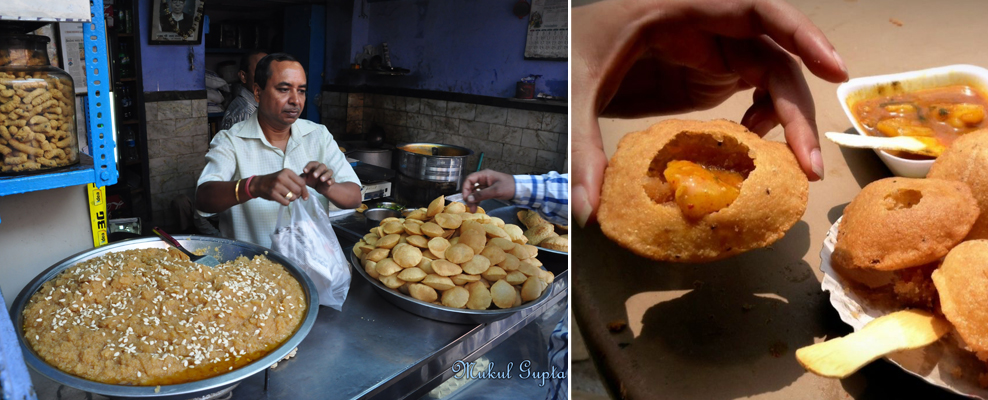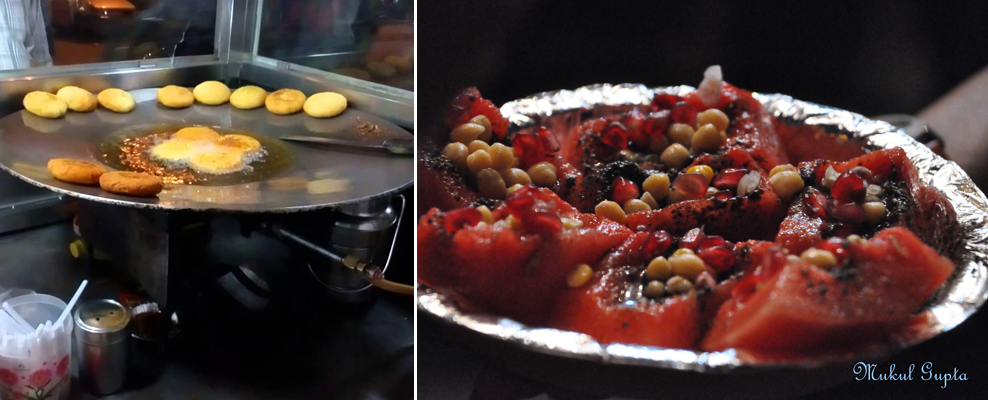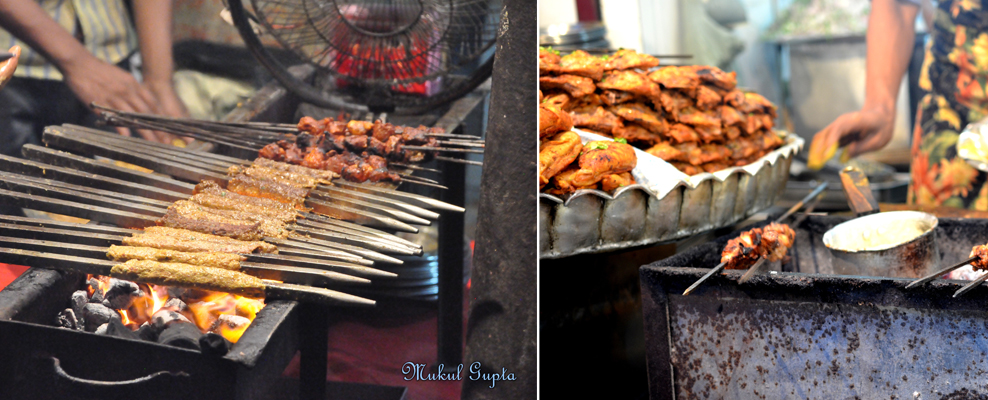We notice the steam doing its dervish-like dance over the pattals (plates fashioned out of dried leaves) but after waiting several minutes drooling over the plates of others, we refuse to be deterred by trivialities—or the virtue of protracted patience. We pounce upon this perfectly round, evenly golden, temptingly plump poori, or deep fried bread, that’s legitimately ours. With as much civility as our tortured will allows we break off a piece, dunk it into a sea of spices, scoop up a piece of masala-laced potato, and shove it into our craving mouths. The heat teases the palate and we can feel it coursing through our hungry insides. It’s just one bite but determined to not have to repeat the rigmarole—and ignominy—of glaring at others’ pattals while we await ours to be handed over, we go ahead and order a couple more.
This is how you make a gratifying start to the day in Old Delhi, colloquially called Purani Dilli: tuck into hot bedmi-aloo, the aforementioned delight, and follow it up with another unlikely twosome, nagori-halwa (also a crisp savory poori, this one’s hollowed-out and filled with a mildly sweet, gooey semolina pudding, styled like a golgappa).

The walled part of India’s capital owes much of its glory to food. Historic, crumbling and atmospheric it may well be but this part of Delhi finds inspiration—and the will to survive—from food that’s not mere fuel but an experience. Within the radius of a couple of kilometers, a network of arteries and alleys holds wicked temptations with a smorgasbord of delicacies: rich, mostly calorific, eye-and-mouth-watering, seldom tummy-troubling but always delicious knock-outs. There are tangy chaats, mellowy kulche-chhole, crispy kachoris, spicy pao bhaji and several specialties unique to these parts.
Mastering the art of making the specialty bedmi-aloo and nagori-halwa requires a skilled chef and plenty of practice. The chaps at Ram Swarup Halwai in Sitaram Bazaar have been doing it for more than seven decades and it doesn’t look like they, or their patrons for that matter, are likely to get bored anytime soon. The shop does insane business every morning until it runs out of its huge vats, usually by noon. Their food is so good that you’ll forget everything, including the time of day.

Not that time matters, not in these parts. For, no matter what the clock shows, it’s always a good time for some bite or another. Chawri Bazar, claimed to have once been the promenade of the Walled City, is now a market dedicated to mundane things like hardware and paper. Foodies though will claim it for specialties like kulhe ki chaat made by filling in scooped-out vegetables—potatoes, cucumbers, sweet potatoes, banana, tomato—with a concoction of chickpeas, pomegranate seeds and chutney, all spiked with generous amounts of chaat masala and lemon juice. For four generations, Hira Lal Chaat Corner has been peddling these, along with tikkis and pao bhaji. Kulhe ki chaat is a light, refreshing appetizer and perhaps the only un-fried thing you’re likely to spot for miles, along with the ubiquitous shakarkandi (sweet potato) chaat, sprouts chaat and soya kebabs. In a way that makes good food sense for you can sin in the hereafter. A stone’s throw from Hira Lal, also in Sitaram Bazaar, is the shop of Lala Duli Chand Naresh Gupta (Kulfiwale) where the humble kulfi transforms into avant-garde culinary art. The old-timer hawks the Indian gelato in several fruity flavors—none of which is synthetic—and variants like orange are served in the skin complete with the slightly bitter, sour-sweet taste of the real fruit. It’s also the place to indulge your taste buds with rich, creamy kulfis in innovative flavors like rose and, would you believe it, tamarind.

But let’s not delude ourselves. For most gourmands, there is only one justification for the existence of Old Delhi’s tight lanes: smoked, spiced, succulent non-vegetarian delicacies often made with secret Mughlai recipes passed down generations of royal chefs, the revered khansamas. You don’t need to ask for directions, just follow your nose but, if you must insist, start off with the food joints opposite the magnificent Jama Masjid and inch your way in through the side street called Matia Mahal Road. The roadside eateries work the graveyard shift and soon after the muezzin calls out the maghrib (evening namaz) at the 17th-century mosque, Urdu Bazaar magically transforms from a market of books to food heaven. The aroma of tikkas and seekh kebabs leisurely roasting on skewers and the sight of the burning embers in hot tandoors can make a mighty wrestler weak. Try the succulent buff kebabs of Mushtaq Seekh Kebab or its next-door neighbor Lalu Kebabi to know the real McCoy. Marinated in a deadly secret concoction and served with onion rings wrapped in green chutney, the kebabs are juicy, tender and flavorful. And we’ve only just begun.
Walk into Matia Mahal Road, the lane snaking in from Urdu Bazaar, and a few steps ahead is Haji Mohd Hussain’s eponymous shop selling chicken and fish fry. It’s crowded most evenings but for the determined it is but a cinch popping the fish, deliciously marinated and deep fried to golden, into the mouth while jousting with the crowds. At Aslam Chicken Corner, not far from the fish fries, butter chicken acquires an entirely new—and very literal—meaning. Here tandoori chicken is dunked in a mixture of yogurt and copious amounts of butter, sprinkled with chaat masala and served hot; roomali rotis act as perfect accompaniments and also work wondrously to soak up the molten butter. This is the same lane that houses the iconic Al Jawahar—they, the makers of the scrummiest nihari and paya—and the much-vaunted Karim’s. The spatial fissures of cuisine are rigidly set in Old Delhi; while the area around Jama Masjid and Lal Kuan are non-vegetarian and renowned for Mughlai dishes, strictly vegetarian food is hawked in and around Chandni Chowk: think dahi bhalle from Natraj, jalebi at Dariba, khurchan at Kinari Bazaar.

Speaking of sweets, the options for rounding off a gastronomic odyssey too are aplenty in these parts. From cold (like lassi, kulfi and kheer) to hot like gulab jamun, you’ll have a tough time weighing in your choices. Once again, no matter where you find yourself in the area there’ll be something sweet close by. Like rabri-falooda at the legendary Giani’s, kheer at Hauz Qazi Chowk’s bade mian, and shahi tukra (royal bread pudding) at Cool Point in Matia Mahal Road. However, if your threshold for sweets is low and all you can muster is just one dessert and no more, make it daulat ki chaat, a winter exclusive found in Lucknow by another name nimish and in Varanasi as malaiyyu. It’s a foamy, wispy sweet made all night with churned milk, pistachios and saffron. The shelf life of this dessert is very low—like daulat or wealth it doesn’t last long, they say—and perhaps that is what it owes its moniker to. Khemchand Adesh Kumar in Nai Sadak and Pushpendra & Vinod Kumar in Chawri Bazaar are masters in the making of the most foamy daulat ki chaat.
Old Delhi’s gastronomic odyssey is nothing less than Alice’s adventure. Call it utter gluttony or the beauty of the spot-on flavors of the super foods, one can never be satiated enough. This is where you must determinedly banish ugly thoughts of calories and obesity and just do what we’ve learnt to do. Surrender.
